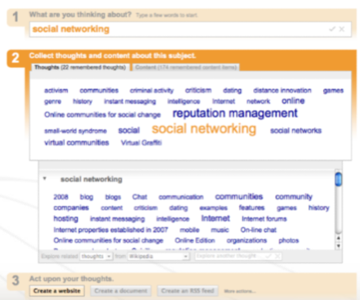Part Two of a Two-Part Series. Part one can be found here.
At this month’s DEMO 09 conference, one of the most apparent trends was the emergence of several new intelligent web services. In this transitional period between Web 2.0 and Web 3.0 (or whatever it is that comes next), the tools of the future are just now being revealed. Although at first glance some of these services and applications may seem somewhat incomplete, in many cases they actually represent years’ worth of work to have reached the point they’re at now. These are no simple Web 2.0 applications; these are highly complex and intelligent tools of tomorrow’s smarter web.

Yesterday, we examined a handful of services which represent this emerging class of intelligent services and today we’ll look at a couple more.
A.I.-Powered Shopping (Gazaro)
Gazaro is a new service that lets you make what they call “personal sales fliers.” Instead of sifting through the local paper to find the latest deals, you just tell Gazaro what sorts of products you’re interested in. The service then scours the web for the best deals and presents its findings in a clean, easy-to-read interface. But Gazaro isn’t simply a price comparison engine. It’s a really smart one.

Gazaro knows that a “camera” is a “camera” or that an “LCD” is an “LCD.” It’s not doing simple keyword matching, it really understands the difference. In other words, you’ll never get results for a camera lens or camera accessories when you’re searching for just a camera because Gazaro knows those are not the same things.
The reason it can differentiate between items is because it’s powered by Artificial Intelligence (A.I.) on the back end. In this case, “A.I.” is no buzzword – the company was incubated by Apption Software who had developed A.I. technology for use in the enterprise. They realized that the same technology could deliver value in a consumer application as well, and from there came Gazaro.
When Gazaro goes out and crawls the internet, it compares the items it finds to the items it already knows in order to determine what exactly the new items are. If it encounters something it doesn’t know, it makes an educated guess using its A.I. “brain.” And the more it crawls, the more it learns.

After identifying what an item is, Gazaro then determines if the item found is actually a good deal. How good of a deal it is or not is represented with the “Gazaro Deal Score.” These deal ratings are based on Gazaro’s knowledge of historical prices, how often an item goes on sale, what other retailers are selling it for now and what they’ve sold it for in the past. All that analysis is done using the A.I. technology in order to rate the deal on a scale from 1 to 10, with 10 being the best deal.
To the consumer using the system, the complexity of what the A.I. is doing is all hidden behind the scenes. The end user only sees a simple interface where they can enter in the items they’re shopping for and then find the best prices. Gazaro can also alert users to new sales and deals using email, RSS, or Twitter. At the moment, Gazaro is for consumer electronics shopping only, but in time the system could expand and learn more product categories.
Understanding Intentions (Primal Fusion)
Another company of interest is Primal Fusion whose new “thought networking” service is a semantic technology platform designed to help you research the subjects that interest you. Unfortunately, “thought networking” is a buzzword-sounding phrase that doesn’t really convey what the system does. Primal Fusion essentially is an alternative to doing traditional web searches when you want to learn about a particular topic.

Once signed up for the Primal Fusion service, you enter in your topic in the search box provided and you’ll see a tag cloud of words appear which are relevant to the word you initially searched on. You can either select those words by checking them or you can click on the individual words to further drill down into a more specific aspect of the original topic.
In the example they demonstrated today, a student researching climate change might see a tag cloud featuring words and phrases like “pollution,” “co2,” “greenhouse gases,” etc. In addition, the service can also return relevant photos to your topic from sites like Flickr.
Initially, Primal Fusion searches Wikipedia to deliver the tag cloud, but once you have your specific interests checkmarked you can then change a drop-down box to search the web instead. This web searching is done courtesy of a Yahoo BOSS integration and it’s here where Primal Fusion one-ups a normal search engine. Instead of just returning the top 5 or 10 results on the original keyword, it sifts through all the results found and returns only those relevant to your specific interests – even if those results would have been pages deep on a normal search query. Whatever Primal Fusion retrieves can then be extracted to a web page, document, or RSS feed. At the moment, Primal Fusion only extracts to web pages – files and feeds will come later. The web pages created by the service are public sites representing your research around a particular topic and are filled with links and images relevant to your query.

Because Primal Fusion comes off as somewhat of a confusing mind-mapping tool, many folks will probably miss the point: Primal Fusion is infrastructure, not an application. The way it understands the relationships between words and phrases and how it can then extract the most relevant search results based on that understanding is what’s most important about the company’s technology.
Remember: This Is Only the Beginning
If you go out and try most of the services we’ve profiled in this series, you might walk away feeling a bit disappointed. You’ll probably be thinking of all the things the service doesn’t do but that you wished it could. Or perhaps you’ll find the UI unappealing or the recommendations provided somewhat incomplete. However, It’s important to understand that many of these services aren’t ready for mainstream use just yet. Instead, they represent the beginnings of tomorrow’s web – a web that better understands the data it contains. And by better understanding itself, the new intelligent web of the future can then better understand and serve you.










